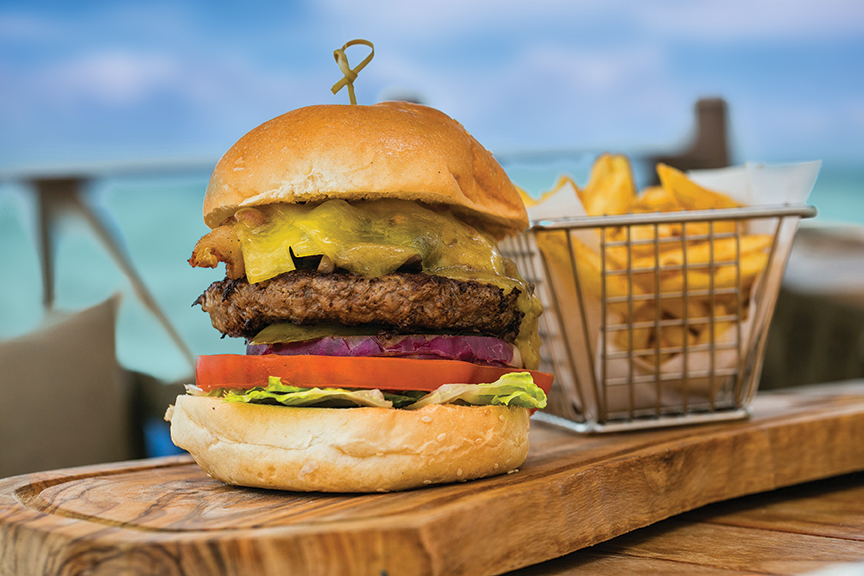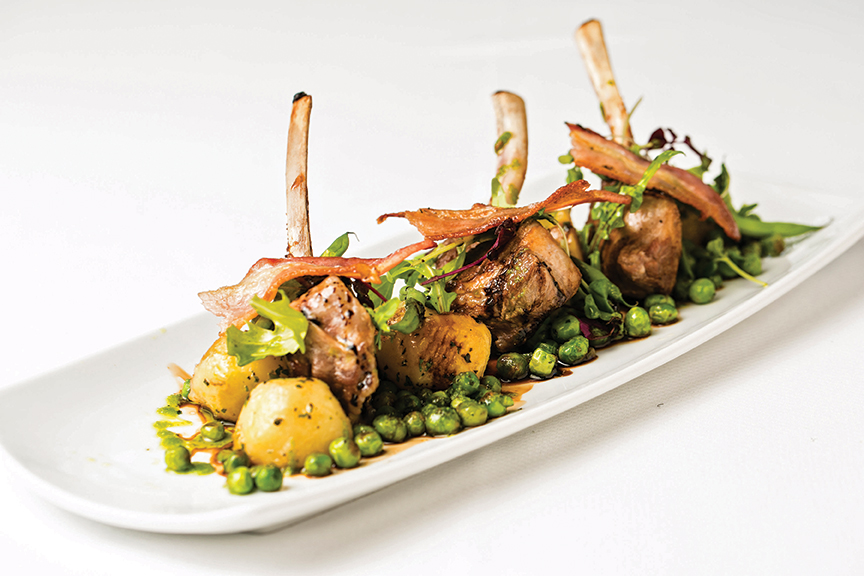Flying Fish and Foie Gras: A World of Flavour and a Sprinkle of Family at The Sandpiper Restaurant
Christophe Poupardin
Executive Chef – The Sandpiper
It’s the little extras that set The Sandpiper restaurant apart: the saffron-butter sauce on top of the traditional steamed Bajan flying fish and saltfish cou-cou; the orange and grapefruit segments at the breakfast buffet, whose white pith is painstakingly removed each morning by kitchen staff; and the smoked Wagyu beef cheeks, braised for twelve hours until they’re fork-tender, their toasted juices melting into herbed mashed potatoes.
— By Amie Watson
— Photography: Kenneth Theysen
“I’ve always lived by the philosophy that guests are our family”, says Australian-born chef Christophe Poupardin. Sitting in a comfortable wicker chair in the lush gardens of The Sandpiper, next to a secluded pool and wood-roofed cabana, the jovial chef makes it easy to see why guests feel relaxed and at home. “This is their restaurant. They can have whatever they want”, he says. That includes everything from a nut-free, gluten-free or dairy-free breakfast, lunch or dinner to a request for simple spaghetti bolognaise instead of the menu’s spaghetti bottarga with air-dried tuna caviar. “I don’t get upset and say they should be eating the filet of beef with foie gras and truffle-butter sauce instead”, he jokes. “We’d even peel your grapes if you asked, but you’d hear the ruckus in the kitchen!”
Besides, after one positive experience, that guest might come back for the foie gras another time. “If guests are here for two weeks, they go out a couple of times, but the majority stay here because the food’s good and they’re relaxed”, he says. “It’s a second home to them. They know the staff – some have been working here for more than forty years. They arrive in the afternoon, settle into their room and come straight down. They don’t take a day or two to unwind after travelling.”
In the fourteen years Poupardin has been the executive chef of the resort, he’s developed a concept that works: a daily changing menu plus signature dishes collected over the years from customer favourites. According to The Sandpiper’s managing director Wayne Capaldi, those are sorted into an “elegant beach” menu for lunch (think Caribbean vegetable samosas, ahi tuna and mango salad, thin-crust pizza and chicken and sun-dried tomato pesto panini) and more “elegant bistro” fare for dinner.
“Our most popular dishes are our lobster salad, anything with red snapper, and our Caribbean shrimp with steamed basmati, scorched mango, ginger and herb butter sauce. Then the beef tenderloin”, says Poupardin. The dessert menu also changes every week, but always includes home-made ice creams and sorbets like Bajan cherry and grapes with white wine. There’s also a pistachio parfait with white chocolate sauce, a dark chocolate tart with peppermint ice cream, and a mango soufflé that’s worth the fifteen-minute wait. For those with less sweet teeth, there’s even a European cheese plate.
But Poupardin had a lot to learn about local cuisine when he first came to the island. In that time, he’s put down roots of his own. He took a break before lunch to talk about his culinary inspiration, adapting his techniques, and making Barbados feel like home.
What brought you to Barbados?
My parents immigrated to Australia in 1966. Times were tough in France, so they packed up and left. My brother and I grew up in Brisbane in Queensland. In high school, I worked in catering and in college I got myself an apprenticeship. After a couple jobs in Australia, I did some backpacking and sightseeing before basing myself in the UK for about ten years. While working at The Lanesborough hotel in London, I’d take extended vacations in Southeast Asia, staying with friends in the hotel industry. It was a good opportunity to broaden my culinary horizons. One day I came back to London from visiting friends in Malaysia and I remember missing home in Australia a little. I was going through customs and a message popped up from a friend who ran a recruitment agency and he told me about this job in Barbados. That was in 2002 and I’ve been here ever since.
Do you ever go back to France?
When I was living in England, it was easy to visit family in France, but I don’t go as often now. I took my daughter this year, though.
How would you describe your menu?
We take a blend of local influences with European flair and we put a little Asian twist in there as well.
How does your French and Australian heritage influence your cooking?
I always had a passion for food, which I think stems from family. My grandmother had a little farm with animals. She cooked old-time foods on one small stove. My mom would always do a little salade entrée, like tuna niçoise, and I remember on Friday nights we always had braised meats, which was very French. While everyone else was having sausages and meat pies, here we were eating ragouts and stews. I hated them! But now I love them. And all these trends are coming back now: slow-cooking, confits, braising. At The Sandpiper, my favourite dish is the beef cheeks, which we cook for about twelve hours until it’s fork-tender. We also have confit duck on our menu and foie gras terrines.
What did you have to learn about local cuisine when you first came here?
I’m still learning! But that’s where the staff come in. It was also about learning the history of the food, like flying fish and cou-cou. It’s a national dish made with a local fish that swims in schools, and if a bigger fish comes along, they jump out of the water. It’s traditionally served with herbs and spices ground down like a jerk seasoning. It can be spicy, but we try to keep it milder. Sometimes if someone bumps into you when they walk past just as you’re putting the chilli in…
So you teach the staff about foie gras and they teach you about cou-cou, the silky smooth stewed okra dish that’s like polenta?
As an expat you have to come with an open mind. I had to change my techniques, my beliefs, my thoughts. One thing I like here is the fresh fish. The sea’s right there. We have a lot of local suppliers that get us a good selection of seafood and fish everyday: barracuda, red snapper, mahi-mahi, tuna, kingfish, lobster.
What else sets The Sandpiper apart?
Every Wednesday there’s the owners’ cocktail party. Guests get an invitation in a little envelope inviting them to Harold’s Bar for drinks. And on Wednesday nights we have a Caribbean/international buffet. On Sundays we have a barbecue with seafood, steaks and ribs on the grill.
Are you still homesick for Australia?
I am, but I have a daughter now and The Sandpiper creates such a family environment. Plus I go back every year. Being here provides that sort of home away from home, and I’m able to do what I enjoy. The management really values their staff and the property. After working in city hotels and restaurants where it’s so corporate, I love that the resort is family-run. So family keeps me here.








